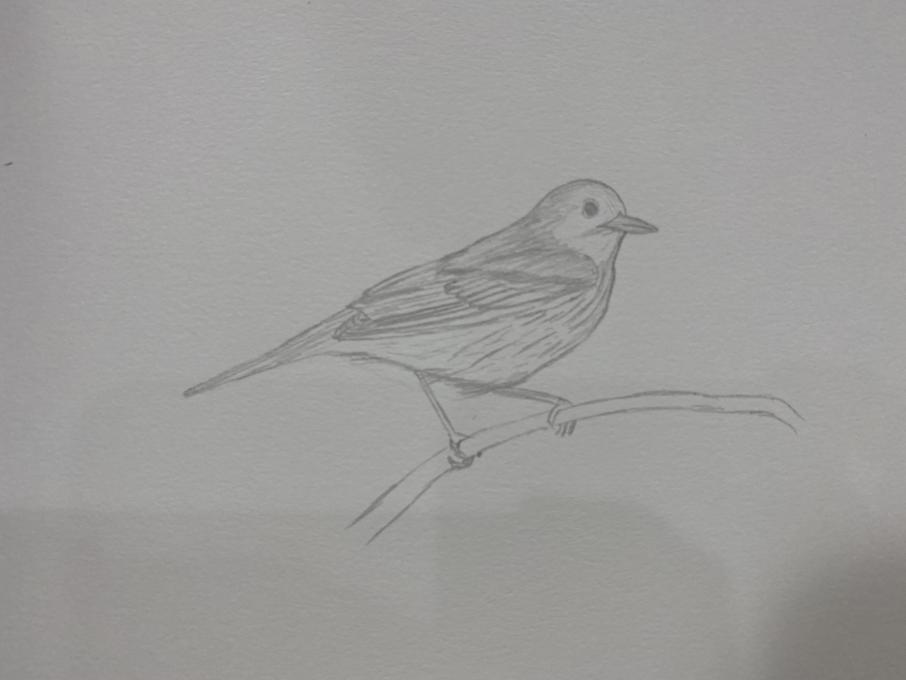The Cornell Lab Bird Academy › Discussion Groups › Nature Journaling and Field Sketching › Jump Right in!
-
1. I felt pretty nervous about drawing from a photo! The hardest part was starting. Once I had started I found getting the proportions challenging. It was also tricky to work out how I would draw the feathers - so much detail. It was easier once I agreed with myself that mistakes were okay and I wasn't trying to recreate the photo in all it's detailed glory.
 2. I hadn't appreciated the diversity in feathering until I focussed on the photo to draw it. I hope with journalling and this course I will learn to focus and see/appreciate things in a new way.
2. I hadn't appreciated the diversity in feathering until I focussed on the photo to draw it. I hope with journalling and this course I will learn to focus and see/appreciate things in a new way. -
Drawing from a photo means that I had more time to notice details that I might not have noticed on a moving subject. Getting the proper proportions correct was a bit challenging. Also, using a pencil, shading to indicate both color and shadows was difficult.

-
Drawing animals isn't something I do often so I felt a tad bit apprehensive. Jumping in and getting started was easier than trying to copy something from an image. I would not have noticed the details of the branches and which way they were growing and that some were broken off. Noticing the bird details was not as critical since I'm a birder. Yes, noticing branches and things that aren't specifically the topic of interest makes the images look more interesting.

-
I found it somewhat easy to copy this, my first attempt, though it was very small and I felt quite stiff. I say relatively easy since with a photo your subject is static which gives you time to start, stop, erase, start over. I was pleased with my first attempt and I am encouraged to plow ahead. In the photo, I think the shading is more noticeable than through observation, and the lichen might have been missed. However, i don;t think those details this would would be my main focus but overall observations.

-
I feel like it was much easier to draw from the photo than trying to draw a bird in nature (which may fly away any moment). There was more time to look at it closely and make more detailed observations (in addition to looking at it really closely). I'm excited to learn how to draw more accurately (and be able to add more details) and how to use watercolors in the field!

-
It was a challenge to work in the Yellow Warbler because it usually takes me a lot of time to paint a bird. This time I tried to work fast, and to make a detailed sketch, I haven't received my journal yet, but I am very excited to work in my classes.

-
Beautiful detail Victoria!
-
-

-
The anatomy of the feathers was hard for me to draw. I also have a problem with beaks. They are ether too small or too big. Drawing birds from photo is a good exercise for me to draw birds from nature later.
-
-

-
1. I enjoyed drawing from the photo, since I could focus on details without having to rely on my memory or worrying about the bird flying off. The easiest was approximating the general shape of the warbler. The more challenging aspects were reproducing the relative orientations of the different parts of the anatomy: head angle, leg placement, layering of wing feathers, and eye size direction of gaze. My color and color distribution was off as well. 2. There were so many details I would have missed, if I had not attempted to draw the warbler, not that I was able to reproduce them in my drawing. I do think that including sketches in my nature journals would improve them a lot.
-
I like drawing from a photo because it gives me time to study the object I want to draw and notice details that would not be apparent in the brief time you get to study a moving object like a bird. It was easy to get the overall scene but getting proper proportions was challenging. Drawing the yellow warbler made me realize that even the legs and feet of the bird are yellow. I would have missed that just looking at a photo. Whe
 n nature journaling I want to train my eye to notice what is actually there, instead of what I assume might be there.
n nature journaling I want to train my eye to notice what is actually there, instead of what I assume might be there. -
Yellow warbler was fun to draw. Looking at the photo gave me time to know the bird and take my time looking into its shape, color and some details. It was easy to depict the main shapes of the bird. The challenging part was showing balance. Drawing from photo made me notice the bird nostrils on beak which I didn't identify from the photo at first glance. Also, the wings, tail relationship. This drawing helps to master some simple techniques that will make drawing the real bird on site a bit easier. Hopefully ! I did start working in my journal. Below are the pages about the Yellow warbler :)



-
Drawing from the photo allowed me to look and reexamine the bird over and over again. Each time I looked at it I noticed something new...like the feather details and tiny talons. Drawing the shape came easier than the details. My drawing seems flat and more of a caricature than a real bird. I think nature journaling will require faster reflexes on my part and perhaps making note of details the first time rather than taking my time as I did with the photo.
-
This was very hard but I loved the exercise. I would not have noticed much of the detail and shading had I not tried to draw it. The shading was especially difficult. I look forward to stretching my skills more!

-
Color shading was the hardest. I wouldn't have noticed it's little feet/claws and how close it's eye is to its beak. I also don't think i realized that birds eyes don't have pupils?
-
I feel like my drawing looked a bit generic. I noticed the many yellow colors in the bird when I drew it as well as noticing the body shape more.
-
This was my first time using the portable water brushes and I feel like I went a little too wet at times. I found that getting the details like the stripes on the belly and shading of the wings was hard with watercolor, but I'm glad I tried it. I certainly wouldn't have noticed how the claws grab around the branch but loosely in some parts and the shape of the beak. I tried so many times to make the beak look just right!
-
 I really enjoyed the entire process because it made me pay close attention to the moss, the shape of the head, the beak. The feet and expression of the bird came easily, whereas the sticks, feathers, and leaves were more challenging--probably because they required some very minute details, and I was more interested in the birds head and feet. All of this would be so useful with field journaling because it is what I pay attention to when it comes to nature--the utility of the claws around the branch, the form of the beak for pecking, etc.
I really enjoyed the entire process because it made me pay close attention to the moss, the shape of the head, the beak. The feet and expression of the bird came easily, whereas the sticks, feathers, and leaves were more challenging--probably because they required some very minute details, and I was more interested in the birds head and feet. All of this would be so useful with field journaling because it is what I pay attention to when it comes to nature--the utility of the claws around the branch, the form of the beak for pecking, etc. -

-
 drawing this bird from a photo was interesting because of the Possebility to look closely at each little detail. Drawing the legs was most challenging because you have to find out where exactly they are bound to the body. And it makes me curious to birds anatomy.
drawing this bird from a photo was interesting because of the Possebility to look closely at each little detail. Drawing the legs was most challenging because you have to find out where exactly they are bound to the body. And it makes me curious to birds anatomy.
-

-
 Drawing this bird brought up a memory: Last year, I rented an old gas station in rural Utah to use as an art studio. I bought a small kiln for firing ceramic sculptures and set it up on the concrete floor of the main room, where they once sold candy bars and heat-radiated hot dogs. Since kiln firing took between 12-14 hours, I had a habit of loading it up at night and then camping behind the building in the back of my truck. One of those mornings, waking up at dawn to the sound of the neighbors letting out their horses, I went inside to check on the status of the kiln. It had completed the firing cycle, but still needed time to cool down prior to unloading. I decided to take the opportunity to stroll down to the trucker cafe for some watery coffee and a breakfast burrito. On my way back, I came upon an unmoving yellow bird laying on the sidewalk. It was still alive, so I cradled it to my chest and brought it back to the gas station, where I called my birder sister for advice. We identified the bird as a yellow warbler. She told me that it was possibly in shock, and the best thing to do would be to keep it warm and hope for a revival. Luckily, the lid of the kiln was the perfect temperature for bringing birds back to life, or so I hoped. I made a small bed out of plastic tupperware and an old shirt, and snuggled my unresponsive patient into the recovery room atop the kiln. I spent the next hour in a state of worry, periodically peeking in at this sweet and brilliantly-colored new friend. In time, the bird righted itself into a sitting position and began to blink. When it seemed ready, I brought it outside for release. It seemed as though the bird sat perched on my finger for a long time before suddenly taking flight to an elm tree. Sweet sweet sweet she's so sweet, I thought. May she be singing today.
Drawing this bird brought up a memory: Last year, I rented an old gas station in rural Utah to use as an art studio. I bought a small kiln for firing ceramic sculptures and set it up on the concrete floor of the main room, where they once sold candy bars and heat-radiated hot dogs. Since kiln firing took between 12-14 hours, I had a habit of loading it up at night and then camping behind the building in the back of my truck. One of those mornings, waking up at dawn to the sound of the neighbors letting out their horses, I went inside to check on the status of the kiln. It had completed the firing cycle, but still needed time to cool down prior to unloading. I decided to take the opportunity to stroll down to the trucker cafe for some watery coffee and a breakfast burrito. On my way back, I came upon an unmoving yellow bird laying on the sidewalk. It was still alive, so I cradled it to my chest and brought it back to the gas station, where I called my birder sister for advice. We identified the bird as a yellow warbler. She told me that it was possibly in shock, and the best thing to do would be to keep it warm and hope for a revival. Luckily, the lid of the kiln was the perfect temperature for bringing birds back to life, or so I hoped. I made a small bed out of plastic tupperware and an old shirt, and snuggled my unresponsive patient into the recovery room atop the kiln. I spent the next hour in a state of worry, periodically peeking in at this sweet and brilliantly-colored new friend. In time, the bird righted itself into a sitting position and began to blink. When it seemed ready, I brought it outside for release. It seemed as though the bird sat perched on my finger for a long time before suddenly taking flight to an elm tree. Sweet sweet sweet she's so sweet, I thought. May she be singing today.

-
Loved the anecdote. Thank you
-
Thank you for the wonderful story.
-
@suzie What a great story. Thanks for sharing.
-
-
 disfrute dibujar utilizando esta foto- pero se que sin movimiento es mas facil. Nunce he podido dubjuar ni pintar los aves en vivo porque muevan tanto- hasta lo deje intentar. Fue facil capturar la forma del cuerpo, pero los detalles mas finos como de la rama, o como dejar espacio blanco tambien fue mas dificil.
disfrute dibujar utilizando esta foto- pero se que sin movimiento es mas facil. Nunce he podido dubjuar ni pintar los aves en vivo porque muevan tanto- hasta lo deje intentar. Fue facil capturar la forma del cuerpo, pero los detalles mas finos como de la rama, o como dejar espacio blanco tambien fue mas dificil. -

-
 I used to draw as a child and now that I am in quarantine I tried to pick back up the habit. At first I was scared because of the time that I haven't draw and that I never draw "real" stuff, just animated. For me the most challenging part was drawing the details and getting the proportions right but drawing the bird as a whole was fun. If I wasn't asked to draw it I would have never noticed the wing proportions; this might help for nature journaling just to get the details right for differentiating species.
I used to draw as a child and now that I am in quarantine I tried to pick back up the habit. At first I was scared because of the time that I haven't draw and that I never draw "real" stuff, just animated. For me the most challenging part was drawing the details and getting the proportions right but drawing the bird as a whole was fun. If I wasn't asked to draw it I would have never noticed the wing proportions; this might help for nature journaling just to get the details right for differentiating species. -
I enjoyed drawing this bird and am looking forward to learning techniques that will allow me to do so with more attention to detail, shading, and composition. I thought the beak was difficult to draw well and am hopeful to improve that over time. I think my drawing lacks the "expression" of the bird in the picture. I guess I think this drawing is kind of flat, but I had fun doing it, so it's all good. I don't think I would have noticed all the details of the feathers if I wasn't asked to draw this bird. In my past drawings I sort of scribble wings, but this time I counted them before I drew them (of course, the number drawn may still not be reality!). This was a fun exercise, and I'm looking forward to learning more and getting better.

Read More:
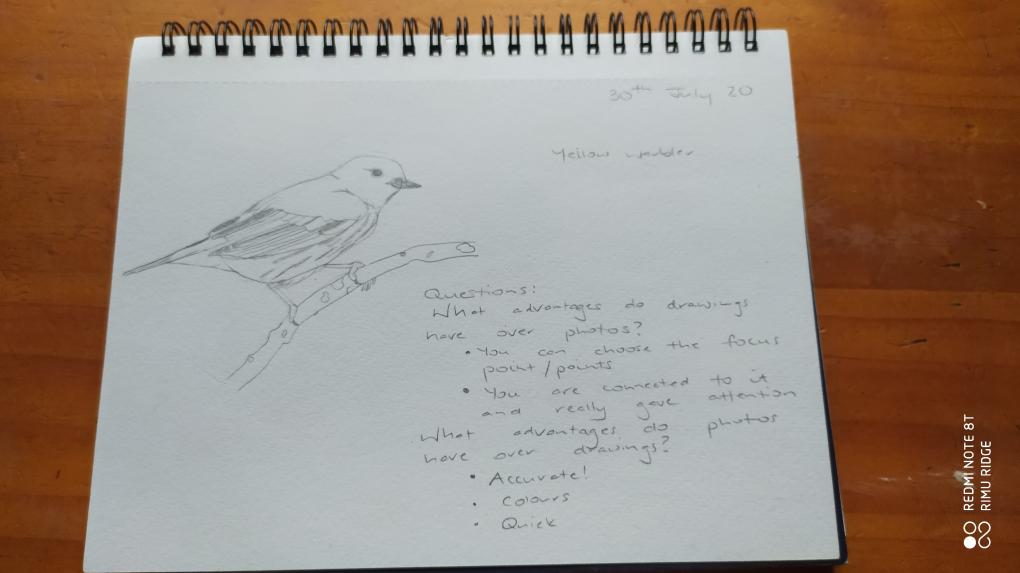 2. I hadn't appreciated the diversity in feathering until I focussed on the photo to draw it. I hope with journalling and this course I will learn to focus and see/appreciate things in a new way.
2. I hadn't appreciated the diversity in feathering until I focussed on the photo to draw it. I hope with journalling and this course I will learn to focus and see/appreciate things in a new way. 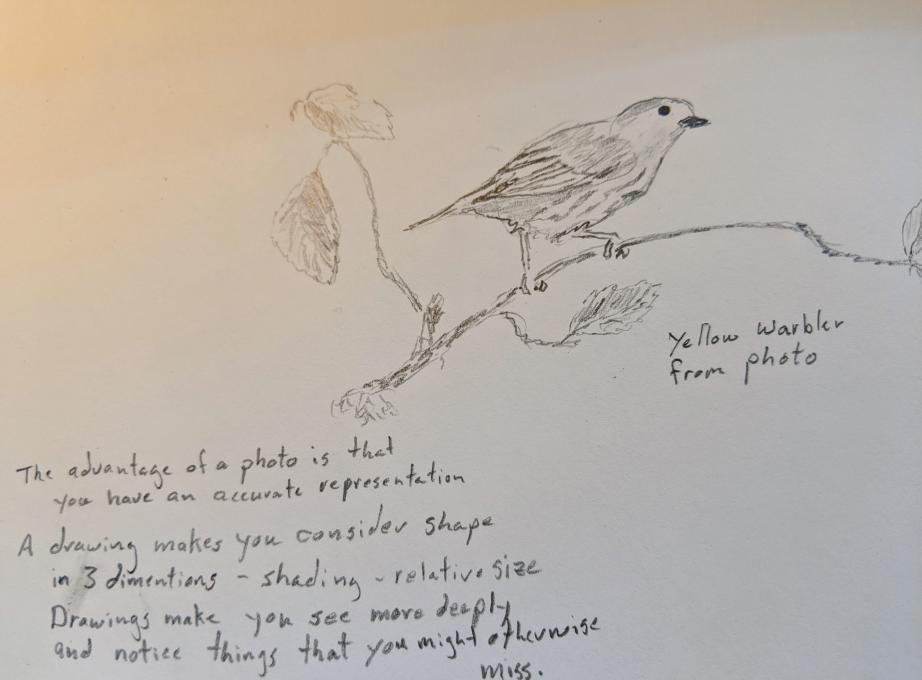
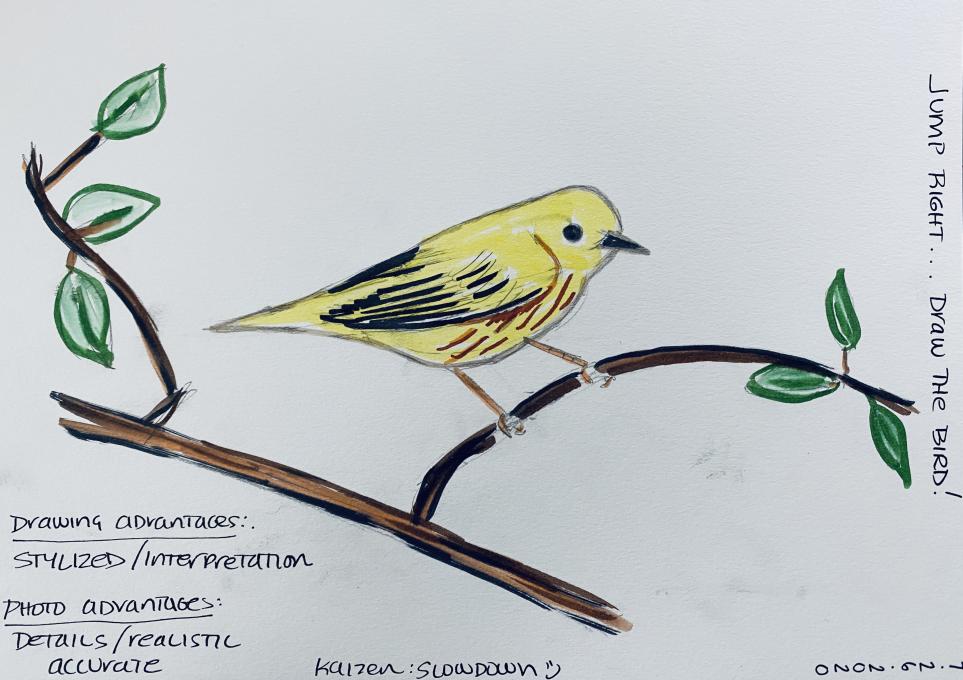
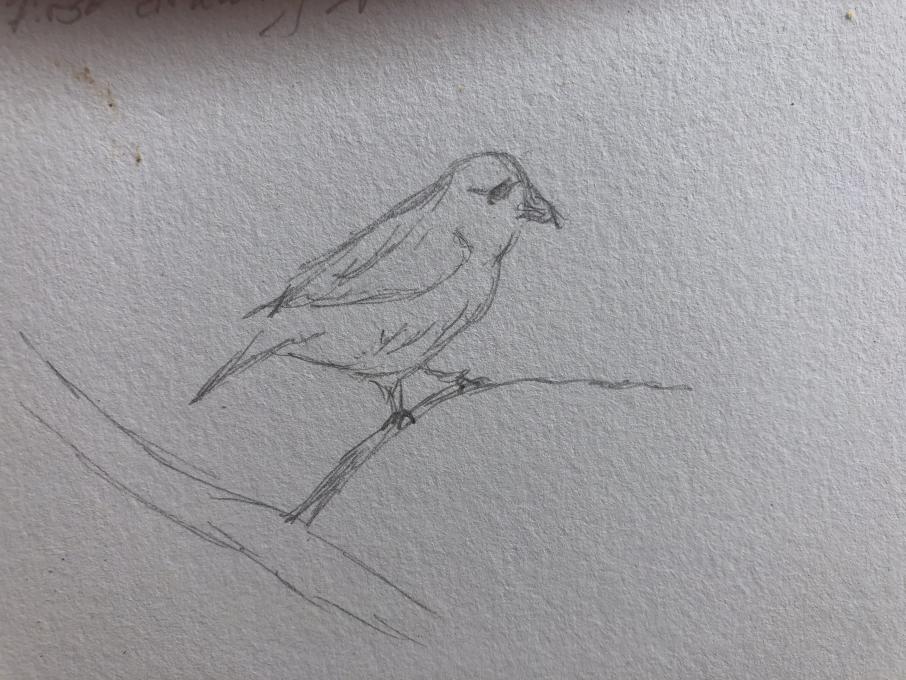
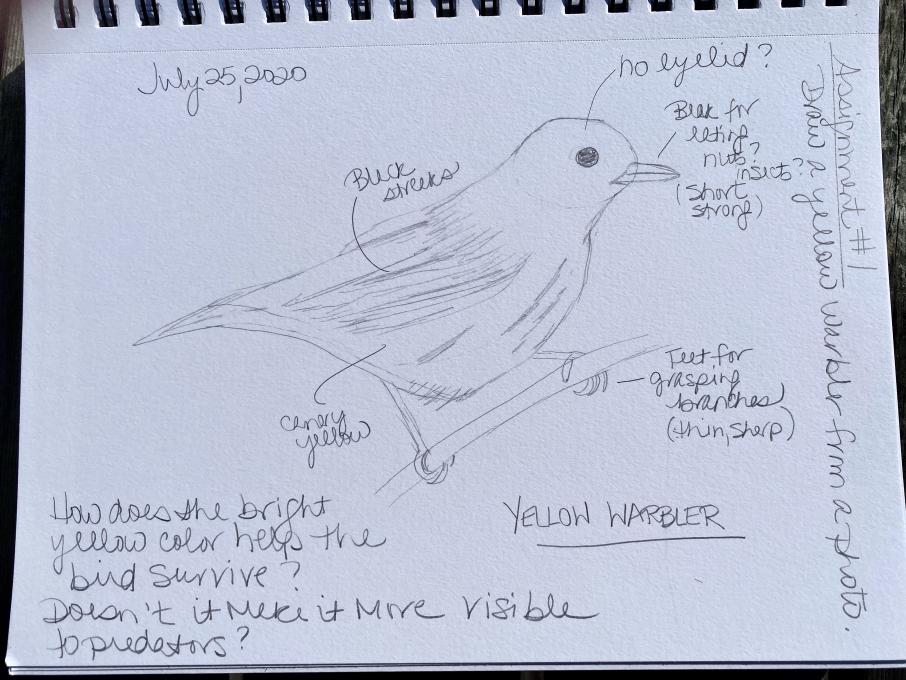
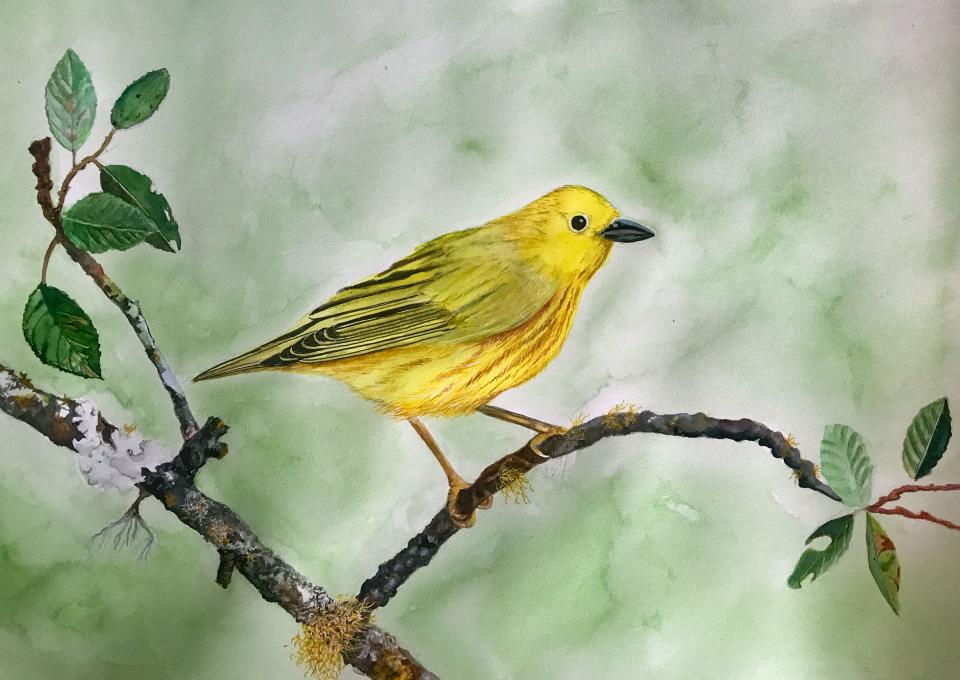

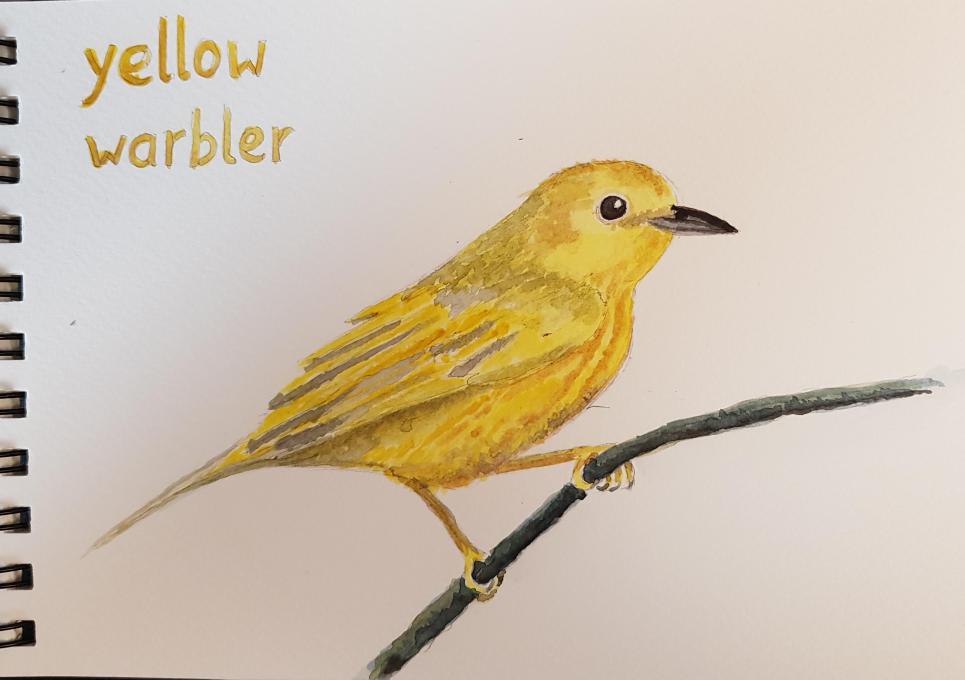
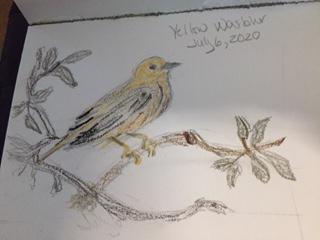 n nature journaling I want to train my eye to notice what is actually there, instead of what I assume might be there.
n nature journaling I want to train my eye to notice what is actually there, instead of what I assume might be there. 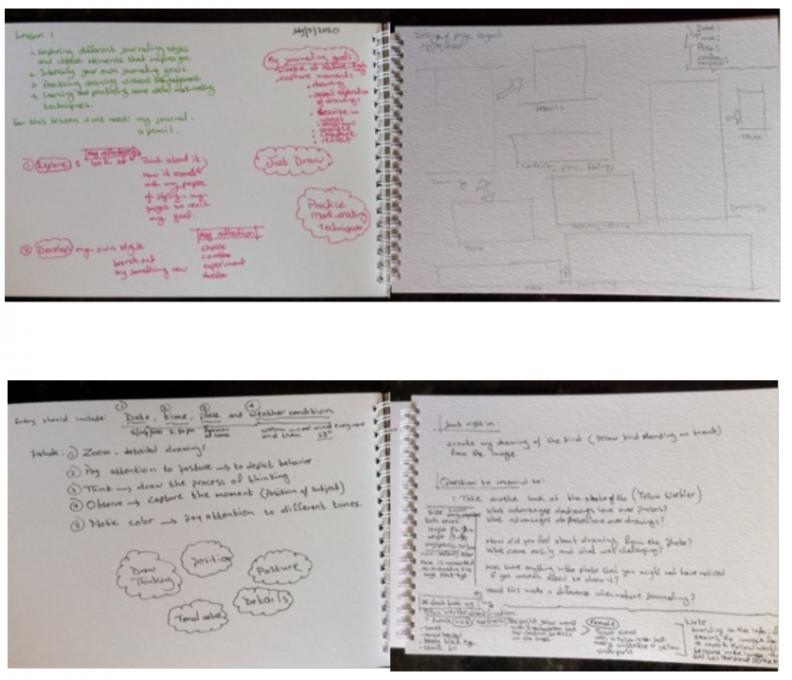
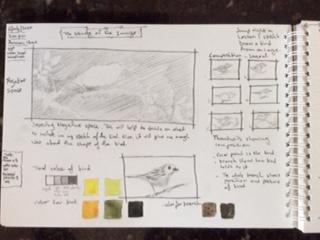
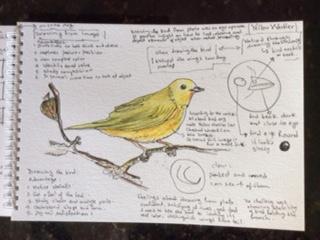
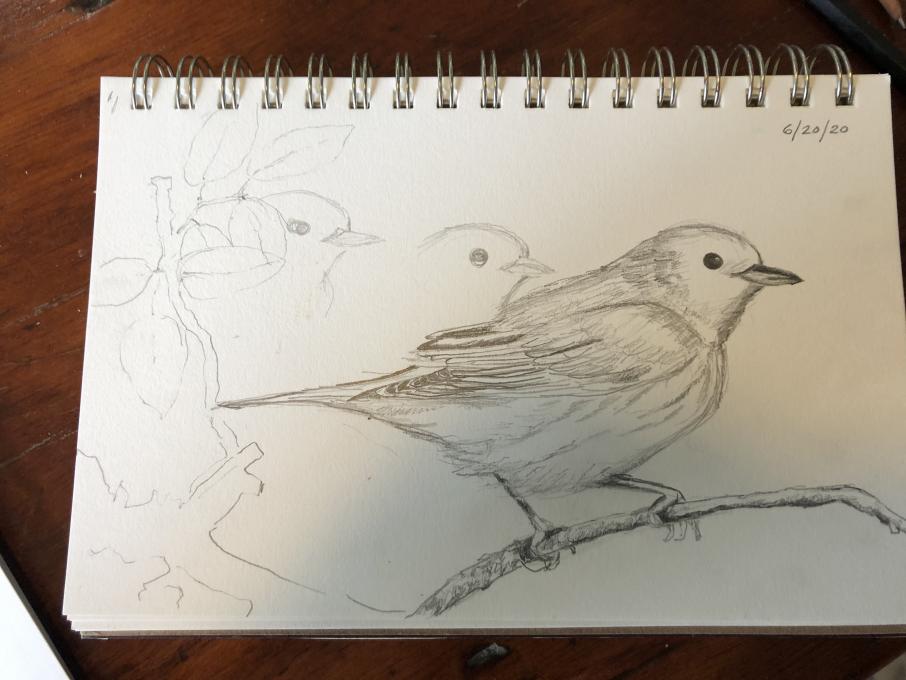
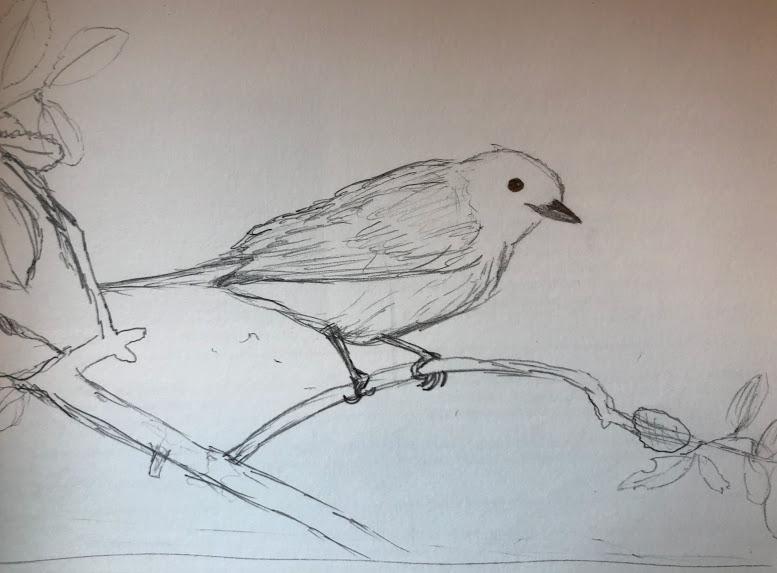 I really enjoyed the entire process because it made me pay close attention to the moss, the shape of the head, the beak. The feet and expression of the bird came easily, whereas the sticks, feathers, and leaves were more challenging--probably because they required some very minute details, and I was more interested in the birds head and feet. All of this would be so useful with field journaling because it is what I pay attention to when it comes to nature--the utility of the claws around the branch, the form of the beak for pecking, etc.
I really enjoyed the entire process because it made me pay close attention to the moss, the shape of the head, the beak. The feet and expression of the bird came easily, whereas the sticks, feathers, and leaves were more challenging--probably because they required some very minute details, and I was more interested in the birds head and feet. All of this would be so useful with field journaling because it is what I pay attention to when it comes to nature--the utility of the claws around the branch, the form of the beak for pecking, etc. 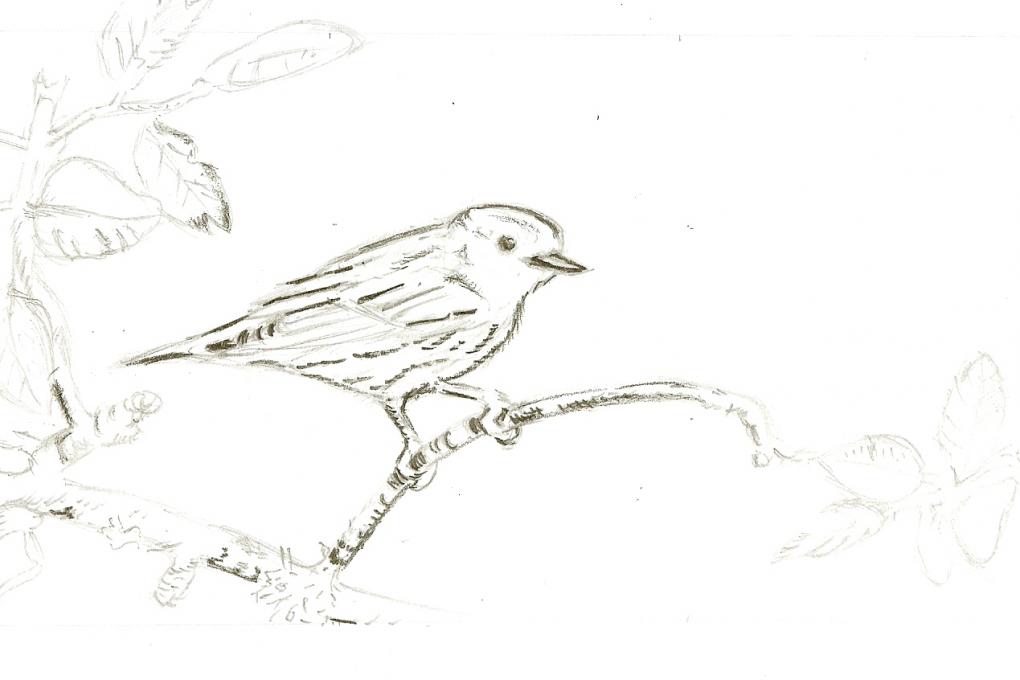
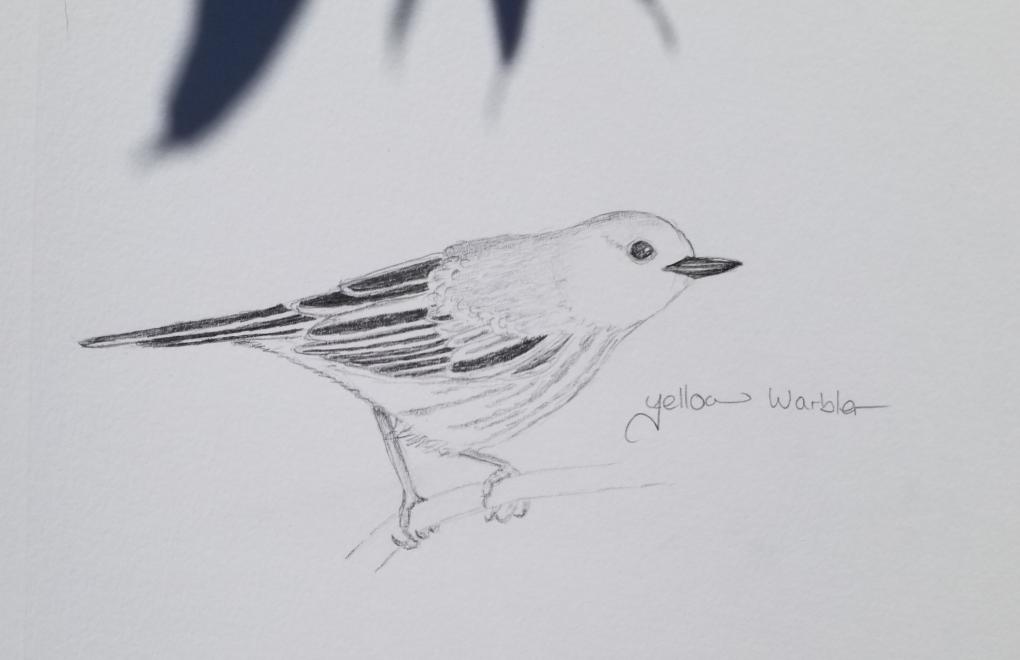 drawing this bird from a photo was interesting because of the Possebility to look closely at each little detail. Drawing the legs was most challenging because you have to find out where exactly they are bound to the body. And it makes me curious to birds anatomy.
drawing this bird from a photo was interesting because of the Possebility to look closely at each little detail. Drawing the legs was most challenging because you have to find out where exactly they are bound to the body. And it makes me curious to birds anatomy.
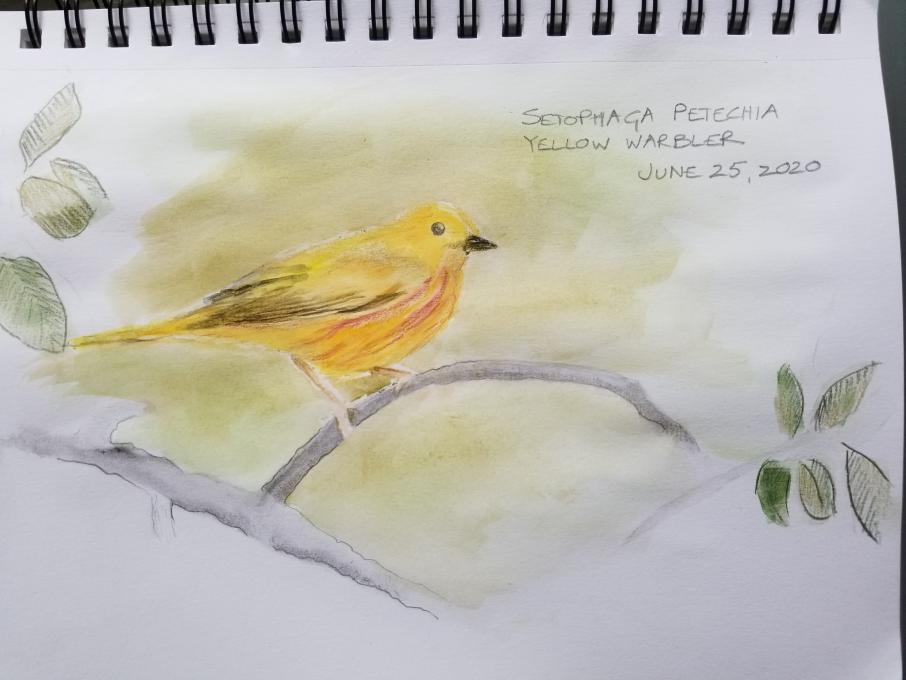
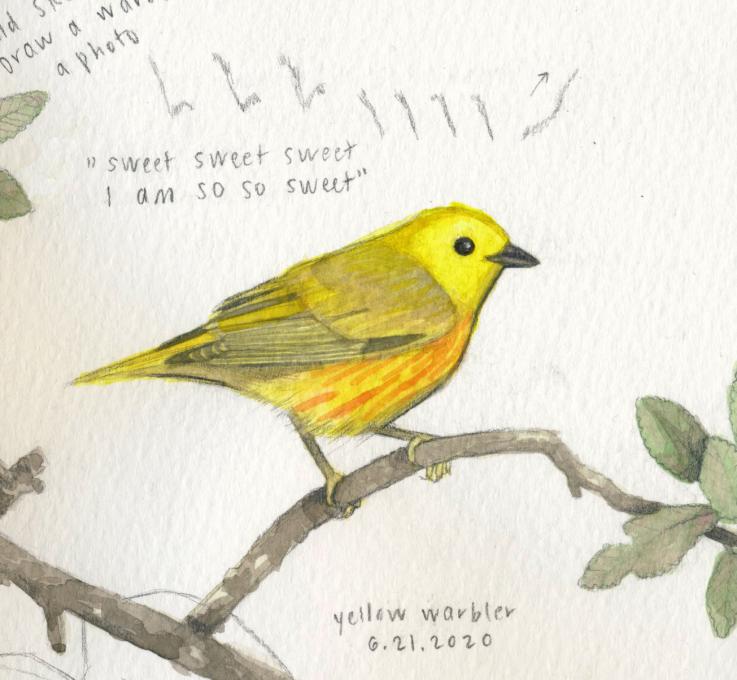 Drawing this bird brought up a memory: Last year, I rented an old gas station in rural Utah to use as an art studio. I bought a small kiln for firing ceramic sculptures and set it up on the concrete floor of the main room, where they once sold candy bars and heat-radiated hot dogs. Since kiln firing took between 12-14 hours, I had a habit of loading it up at night and then camping behind the building in the back of my truck. One of those mornings, waking up at dawn to the sound of the neighbors letting out their horses, I went inside to check on the status of the kiln. It had completed the firing cycle, but still needed time to cool down prior to unloading. I decided to take the opportunity to stroll down to the trucker cafe for some watery coffee and a breakfast burrito. On my way back, I came upon an unmoving yellow bird laying on the sidewalk. It was still alive, so I cradled it to my chest and brought it back to the gas station, where I called my birder sister for advice. We identified the bird as a yellow warbler. She told me that it was possibly in shock, and the best thing to do would be to keep it warm and hope for a revival. Luckily, the lid of the kiln was the perfect temperature for bringing birds back to life, or so I hoped. I made a small bed out of plastic tupperware and an old shirt, and snuggled my unresponsive patient into the recovery room atop the kiln. I spent the next hour in a state of worry, periodically peeking in at this sweet and brilliantly-colored new friend. In time, the bird righted itself into a sitting position and began to blink. When it seemed ready, I brought it outside for release. It seemed as though the bird sat perched on my finger for a long time before suddenly taking flight to an elm tree. Sweet sweet sweet she's so sweet, I thought. May she be singing today.
Drawing this bird brought up a memory: Last year, I rented an old gas station in rural Utah to use as an art studio. I bought a small kiln for firing ceramic sculptures and set it up on the concrete floor of the main room, where they once sold candy bars and heat-radiated hot dogs. Since kiln firing took between 12-14 hours, I had a habit of loading it up at night and then camping behind the building in the back of my truck. One of those mornings, waking up at dawn to the sound of the neighbors letting out their horses, I went inside to check on the status of the kiln. It had completed the firing cycle, but still needed time to cool down prior to unloading. I decided to take the opportunity to stroll down to the trucker cafe for some watery coffee and a breakfast burrito. On my way back, I came upon an unmoving yellow bird laying on the sidewalk. It was still alive, so I cradled it to my chest and brought it back to the gas station, where I called my birder sister for advice. We identified the bird as a yellow warbler. She told me that it was possibly in shock, and the best thing to do would be to keep it warm and hope for a revival. Luckily, the lid of the kiln was the perfect temperature for bringing birds back to life, or so I hoped. I made a small bed out of plastic tupperware and an old shirt, and snuggled my unresponsive patient into the recovery room atop the kiln. I spent the next hour in a state of worry, periodically peeking in at this sweet and brilliantly-colored new friend. In time, the bird righted itself into a sitting position and began to blink. When it seemed ready, I brought it outside for release. It seemed as though the bird sat perched on my finger for a long time before suddenly taking flight to an elm tree. Sweet sweet sweet she's so sweet, I thought. May she be singing today.
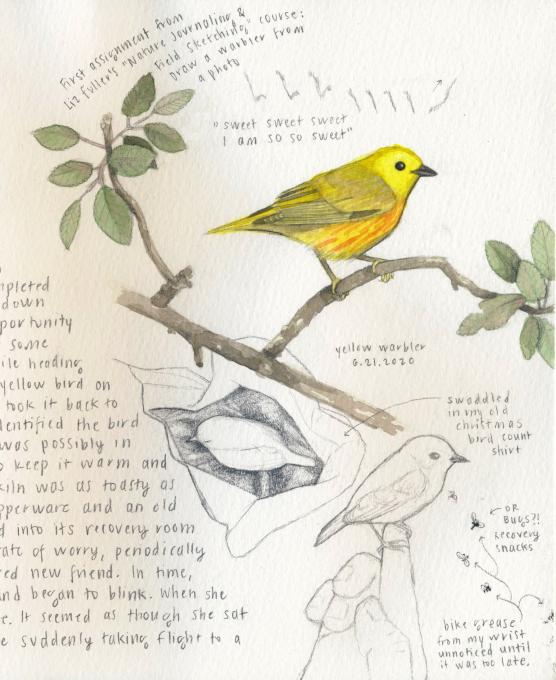
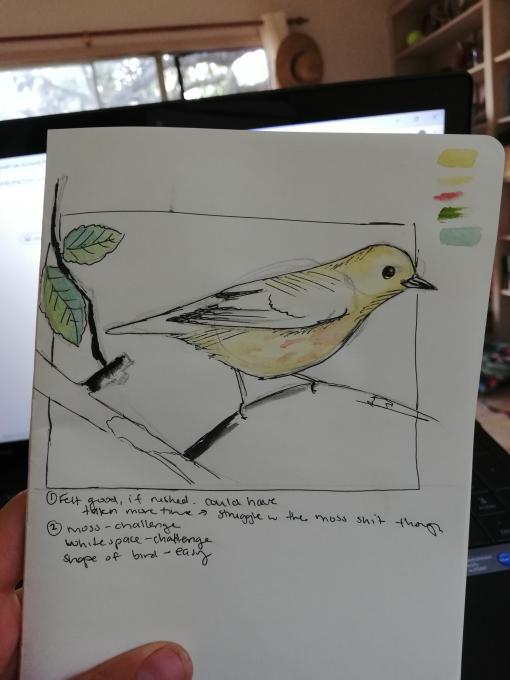 disfrute dibujar utilizando esta foto- pero se que sin movimiento es mas facil. Nunce he podido dubjuar ni pintar los aves en vivo porque muevan tanto- hasta lo deje intentar. Fue facil capturar la forma del cuerpo, pero los detalles mas finos como de la rama, o como dejar espacio blanco tambien fue mas dificil.
disfrute dibujar utilizando esta foto- pero se que sin movimiento es mas facil. Nunce he podido dubjuar ni pintar los aves en vivo porque muevan tanto- hasta lo deje intentar. Fue facil capturar la forma del cuerpo, pero los detalles mas finos como de la rama, o como dejar espacio blanco tambien fue mas dificil. 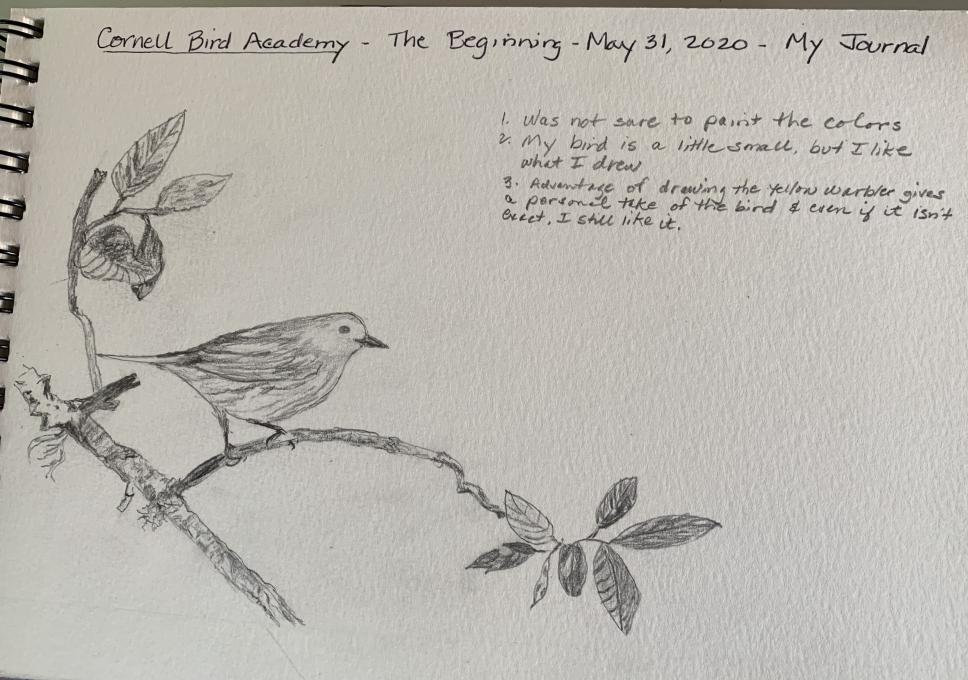
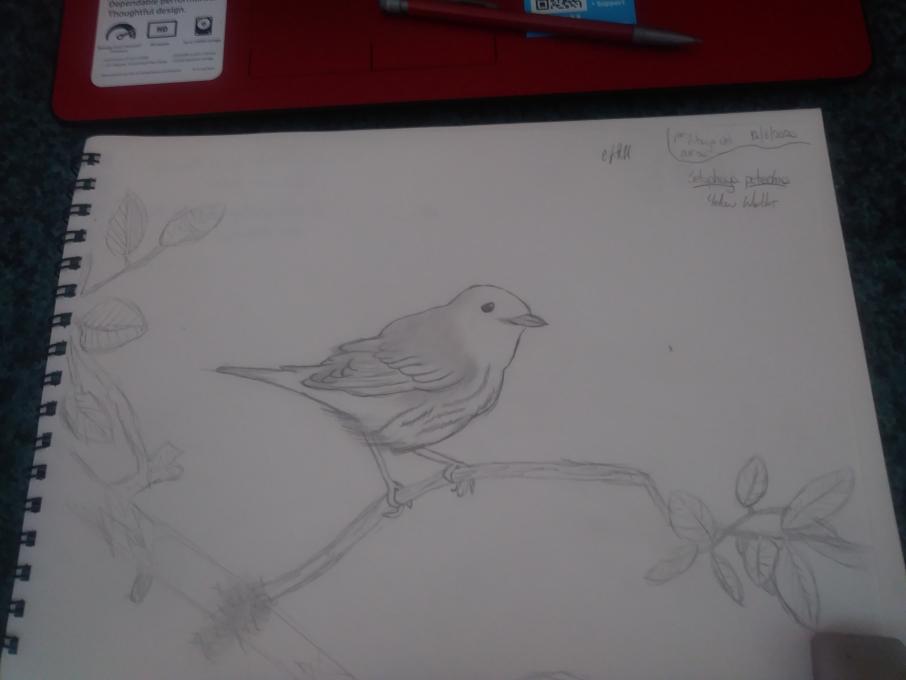 I used to draw as a child and now that I am in quarantine I tried to pick back up the habit. At first I was scared because of the time that I haven't draw and that I never draw "real" stuff, just animated. For me the most challenging part was drawing the details and getting the proportions right but drawing the bird as a whole was fun. If I wasn't asked to draw it I would have never noticed the wing proportions; this might help for nature journaling just to get the details right for differentiating species.
I used to draw as a child and now that I am in quarantine I tried to pick back up the habit. At first I was scared because of the time that I haven't draw and that I never draw "real" stuff, just animated. For me the most challenging part was drawing the details and getting the proportions right but drawing the bird as a whole was fun. If I wasn't asked to draw it I would have never noticed the wing proportions; this might help for nature journaling just to get the details right for differentiating species. 